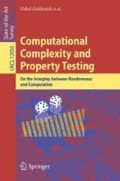Abstract
We consider new complexity measures for the model of multilinear circuits with general multilinear gates introduced by Goldreich and Wigderson (ECCC, 2013). These complexity measures are related to the size of canonical constant-depth Boolean circuits, which extend the definition of canonical depth-three Boolean circuits. We obtain matching lower and upper bound on the size of canonical constant-depth Boolean circuits for almost all multilinear functions, and non-trivial lower bounds on the size of such circuits for some explicit multilinear functions.
Access this chapter
Tax calculation will be finalised at checkout
Purchases are for personal use only
Notes
- 1.
In contrast to the notation used here, in the other sections of this paper, the depth of the canonical circuits is denoted \(d+1\), whereas d corresponds to the depth of general multilinear circuits.
- 2.
In contrast, the notation \({\mathtt{AN}}_d\) used in the revised version of [4] that appears in this volume refers to the maximum between the arity and the number of gates in the circuit; that is, \(\mathcal{AN}_d(F)\le m\) if there exists a multilinear circuit C of depth d that computes F such that C has arity at most m and at most m gates.
- 3.
Indeed, a circuit with a single gate is defined to be (1, 1)-decomposable.
- 4.
This non-homogeneous form (i.e., the added constant 1) may be avoided by using \(\prod _{j\in J}x^{(j)}_{n+1}\), for an adequate \(J\subseteq [t]\), and setting all \(x^{(j)}_{n+1}\)’s to 1.
- 5.
Note that it is easy to show that the n-bit parity function, denoted \(\mathtt{PAR}_n\), satisfies \(\mathtt{A}_{d}(F)\ge \mathtt{AN}^{(d-1)}(\mathtt{PAR}_n)=\varOmega (n^{1/d})\).
- 6.
This technique was used in [5, Sec. 5].
- 7.
Formally, we can write each of the \(r^2\) entries as a fixed linear combination of at most \(r^2/2\) symbolic variables. Viewing these \(r^2\) entries as an \(r^2\)-dimensional vector, we note that this vector must resided in a fixed vector space of dimension at most \(r^2/2\) over \(\mathbb {F}_2\), which in turn can be characterized by a fixed system of at least \(r^2/2\) independent linear equations.
- 8.
Indeed, in [5, Thm. 5.6], \(s=m\).
- 9.
Added in revision: This is no longer the case, since [3] presented an explicit \(\mathrm{poly}(1/\epsilon )\)-linear function \(F_\epsilon \) such that \(\mathtt{A}_{2}(F_\epsilon )\ge n^{1-\epsilon }\) for every constant \(\epsilon >0\). Hence, \(\mathtt{A}_{d}(F_\epsilon )\ge \mathtt{A}_{d+1}(F_\epsilon )\ge n^{(2-2\epsilon )/(d+1)}\) holds for every odd d.
References
Alon, N., Goldreich, O., Håstad, J., Peralta, R.: Simple construction of almost \(k\)-wise independent random variables. Random Struct. Algorithms 3(3), 289–304 (1992)
Goldreich, O.: Three XOR-lemmas — an exposition. In: Goldreich, O. (ed.) Studies in Complexity and Cryptography. Miscellanea on the Interplay between Randomness and Computation. LNCS, vol. 6650, pp. 248–272. Springer, Heidelberg (2011). https://doi.org/10.1007/978-3-642-22670-0_22
Goldreich, O.: Improved bounds on the AN-complexity of multilinear functions. In: ECCC, TR19-171, November 2019
Goldreich, O., Wigderson, A.: On the size of depth-three Boolean circuits for computing multilinear functions. In: ECCC, TR13-043, March 2013. See revised version in this volume
Goldreich, O., Tal, A.: Matrix rigidity of random Toeplitz matrices. In: ECCC, TR15-079, May 2015
Jukna, S.: Boolean Function Complexity: Advances and Frontiers. AC, vol. 27. Springer, Heidelberg (2012). https://doi.org/10.1007/978-3-642-24508-4
Mossel, E., Shpilka, A., Trevisan, L.: On \(\epsilon \)-biased generators in \(NC^0\). In: 44th FOCS, pp. 136–145 (2003)
Naor, J., Naor, M.: Small-bias probability spaces: efficient constructions and applications. SIAM J. Comput. 22(4), 838–856 (1993)
Valiant, L.G.: Graph-theoretic arguments in low-level complexity. In: Gruska, J. (ed.) MFCS 1977. LNCS, vol. 53, pp. 162–176. Springer, Heidelberg (1977). https://doi.org/10.1007/3-540-08353-7_135
Valiant, L.G.: Exponential lower bounds for restricted monotone circuits. In: 15th STOC, pp. 110–117 (1983)
Author information
Authors and Affiliations
Corresponding authors
Editor information
Editors and Affiliations
Rights and permissions
Copyright information
© 2020 Springer Nature Switzerland AG
About this chapter
Cite this chapter
Goldreich, O., Tal, A. (2020). On Constant-Depth Canonical Boolean Circuits for Computing Multilinear Functions. In: Goldreich, O. (eds) Computational Complexity and Property Testing. Lecture Notes in Computer Science(), vol 12050. Springer, Cham. https://doi.org/10.1007/978-3-030-43662-9_17
Download citation
DOI: https://doi.org/10.1007/978-3-030-43662-9_17
Published:
Publisher Name: Springer, Cham
Print ISBN: 978-3-030-43661-2
Online ISBN: 978-3-030-43662-9
eBook Packages: Computer ScienceComputer Science (R0)

